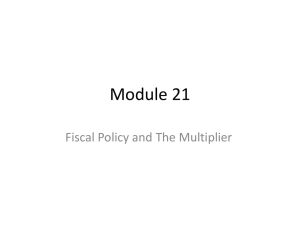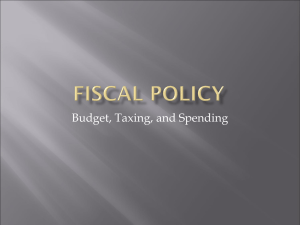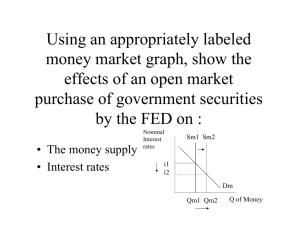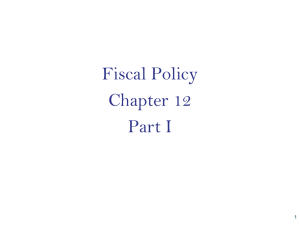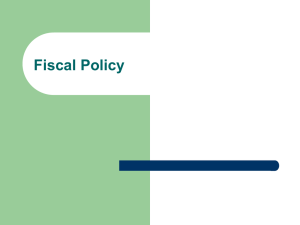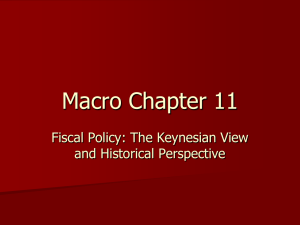Chapter 21
advertisement
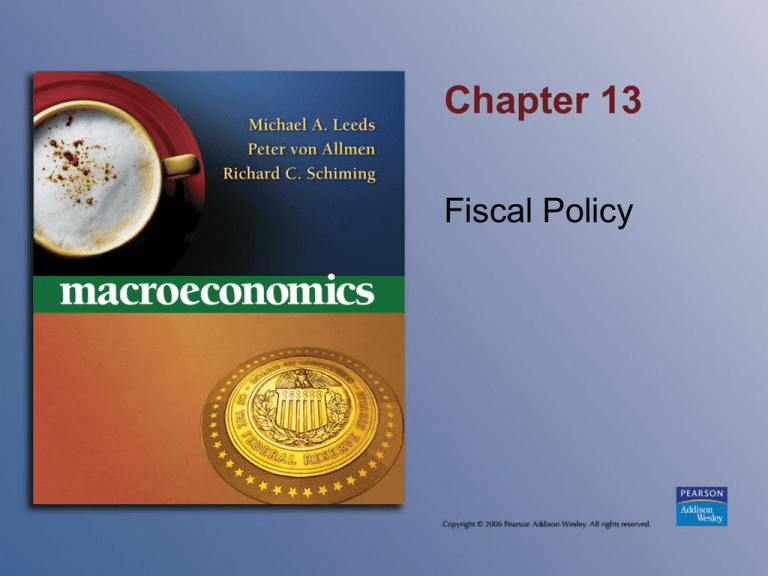
Chapter 13 Fiscal Policy The Multiplier Formula (cont’d) • Can use this formula to find the impact on real GDP of any given change in aggregate demand: A change in any Change in m component of AD Real GDP The Government Spending Multiplier • Used to determine the change in government spending needed to close a recessionary gap: Size of the Recessionary Gap Increase in Government Spending Basic Spending Multiplier • Example: Suppose the government wants to close a $0.5 trillion recessionary gap: If the MPC = 0.9, the spending multiplier is 1 / (1–.09) = 10. Thus, the required increase in government spending is $0.5 trillion / 10 = $0.05 trillion ($50 billion). The Tax Multiplier Process • The government could also chose to lower taxes to increase AD • Tax cuts take longer to impact the economy. Personal tax cuts: • Must first increase disposable income • Must be perceived as permanent Business tax cuts: • Must improve the profit outlook for businesses • It takes time for investment to take place. The Effect of Taxes on Household Consumption • The impact of personal tax cuts is diluted because some of the additional disposable income is saved. Multiplier effect from a change in taxes < that resulting from an equivalent change in government spending. The multiplier must also reflect the inverse relation between taxes and changes in real GDP. Tax Multiplier (m 1) The Tax Multiplier Equation • Shows much taxes must decrease in order to eliminate a given recessionary gap: Decrease Size of the Recessionary Gap in taxes Tax Multiplier Where the Tax Multiplier = Basic Spending Multiplier 1 The Tax Multiplier Equation (cont’d) • Example: Suppose the government plans to close a $0.5 trillion recessionary gap using a tax cut. Assume the MPC = 0.9. The basic spending multiplier is 1 / (1–0.9) = 10. The tax multiplier is 10 – 1 = 9. The required tax cut is $0.5T / 9 = $0.055T. Note that the required change in taxes is larger than the required change in government spending ($0.05T). Can we do it? (number 5) • Assuming an economy with full employment real GDP of $600 billion, and an actual real GDP of $500 billion, and a MPC = 0.9, answer the following questions. What type of gap exists in this economy? What is the size of that gap? To cure this gap using only changes in government spending means that government spending must (increase, decrease) by $ ___ billion To cure this gap using only changes in taxes means that taxes must (increase, decrease) by $ ___ billion • Recessionary gap • $100 billion • Increase • Decrease 100 $10 1 1 .9 100 $11.11 1 1 1 .9 Contractionary Fiscal Policy (cont’d) • Use of decreased government spending and increased taxes to decrease both aggregate demand and real GDP. Figure 13.2 Curing the Overheating Economy with Contractionary Fiscal Policy Contractionary Fiscal Policy • As a result of contractionary fiscal policy: AD decreases. • If AD decreases by the “right amount”, the economy will move to the full employment level of output. The price level decreases. The unemployment rate rises. • Real GDP declines Contractionary Fiscal Policy (cont’d) • Example: Suppose the government wants to close a $0.5 trillion expansionary gap: If the MPC = 0.9, the spending multiplier is 1 / (1 – 0.9) = 10. Thus, the required decrease in government spending is: $0.5 trillion / 10 = $0.05 trillion ($50 billion). The tax multiplier is 10 – 1 = 9, so the required tax increase is $0.5T / 9 = $0.055T.
